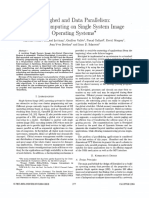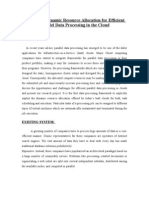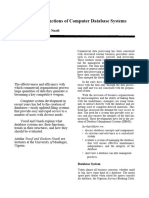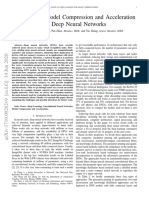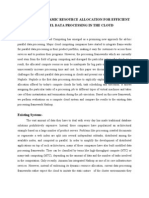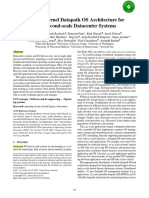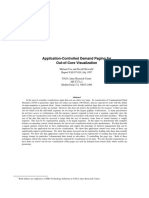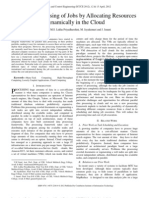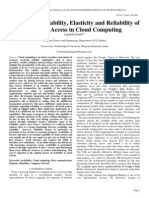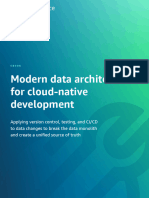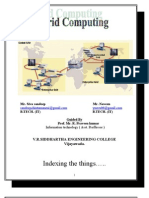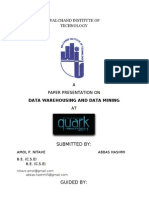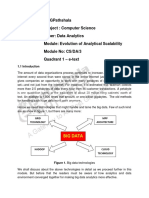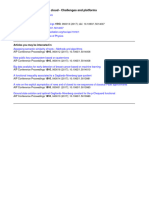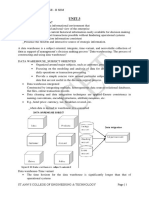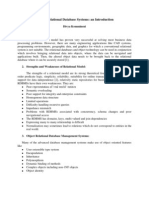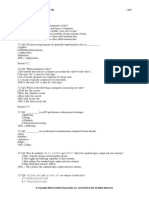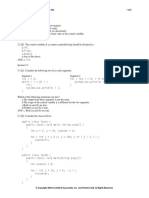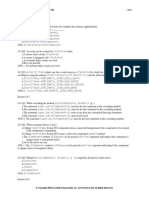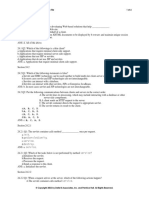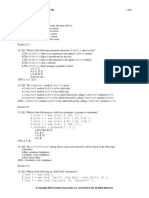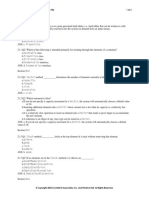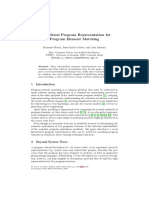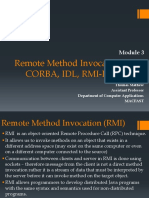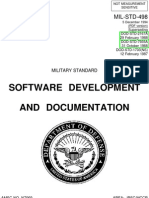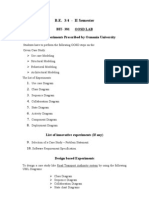0 ratings0% found this document useful (0 votes)
22 viewsComponent-Based Data Mining Frameworks: Fernando Berzal, Ignacio Blanco, Juan-Carlos Cubero, and Nicolas Marin
Component-Based Data Mining Frameworks: Fernando Berzal, Ignacio Blanco, Juan-Carlos Cubero, and Nicolas Marin
Uploaded by
Leonardo Mattera2002-TMiner
Copyright:
© All Rights Reserved
Available Formats
Download as PDF, TXT or read online from Scribd
Component-Based Data Mining Frameworks: Fernando Berzal, Ignacio Blanco, Juan-Carlos Cubero, and Nicolas Marin
Component-Based Data Mining Frameworks: Fernando Berzal, Ignacio Blanco, Juan-Carlos Cubero, and Nicolas Marin
Uploaded by
Leonardo Mattera0 ratings0% found this document useful (0 votes)
22 views4 pages2002-TMiner
Original Title
2002-TMiner
Copyright
© © All Rights Reserved
Available Formats
PDF, TXT or read online from Scribd
Share this document
Did you find this document useful?
Is this content inappropriate?
2002-TMiner
Copyright:
© All Rights Reserved
Available Formats
Download as PDF, TXT or read online from Scribd
Download as pdf or txt
0 ratings0% found this document useful (0 votes)
22 views4 pagesComponent-Based Data Mining Frameworks: Fernando Berzal, Ignacio Blanco, Juan-Carlos Cubero, and Nicolas Marin
Component-Based Data Mining Frameworks: Fernando Berzal, Ignacio Blanco, Juan-Carlos Cubero, and Nicolas Marin
Uploaded by
Leonardo Mattera2002-TMiner
Copyright:
© All Rights Reserved
Available Formats
Download as PDF, TXT or read online from Scribd
Download as pdf or txt
You are on page 1of 4
Fernando Berzal, Ignacio Blanco,
Juan-Carlos Cubero, and Nicolas Marin
Component-based Data Mining
Frameworks
OLAP Vs. OLTP in the middle tier.
oth researchers and practi- usually provide only low-level mining algorithms in order to
B tioners accept that decision
support systems (DSSs) have spe-
information processing capabili-
ties, since they are OLTP-applica-
solve second-order data mining
problems. Both knowledge models
cific needs that cannot be prop- tion-oriented. Here, we propose and dataset metadata might be
erly addressed by conventional the development of custom-tai- stored for later use in the back-end
information systems. Online lored component-based frame- database (for instance, the Object
Transaction Processing (OLTP) works to solve DSS problems, Pool).
systems work with relatively although this approach can be Component-based frameworks
small chunks of information at a extended to a wide range of scien- such as Enterprise JavaBeans (see
time, while DSS applications tific applications. java.sun.com/products/j2ee) and
require the analysis of huge Microsoft .NET (see www.
amounts of data. Online Analyti- A Component-based Data microsoft.com/com/net) are
cal Processing (OLAP) [1], data Mining Framework based on a common architectural
mining [3] and data warehouses An open framework for the devel- pattern, a.k.a. the Enterprise
[7] emerged during the last opment of data mining algorithms Component Framework [5]. A
decade in order to fulfill the and DSSs should include capabili- simplified representation of this
expectations of executives, man- ties to analyze huge datasets, clus- pattern is shown in Figure 2.
agers, and analysts (also known ter data, build classification This pattern, modeled as a para-
as knowledge workers). models, and extract associations meterized collaboration in UML
We have also witnessed the and patterns from input data. The [6], contains six classifier roles
flourishing of component-based conceptual model for such a sys- which are depicted as rectangles:
frameworks during the last few tem is shown in Figure 1.
years (see Communications’ special The data miner (the user of the • Client. Any entity that requests
section on object-oriented appli- system) has to analyze large a service from a component in
cation frameworks, Oct. 1997 datasets and he or she needs to the framework. These requests
and Communications’ special sec- make use of data mining tools to could be performed using spe-
tion on component-based enter- perform a task. Data is gathered cial-purpose data mining query
prise frameworks, Oct. 2000). and data mining algorithms are languages, for example, OLE
These frameworks are intended to used in order to build knowledge DB for Data Mining (see
help developers to build increas- models that summarize the input www.microsoft.com/data/oledb).
ingly complex systems, enhancing data. Those models may provide Instead of calling the com-
productivity and promoting com- the information our user needs, or ponent directly, the client
ponent reuse in well-defined pat- they may just suggest new ways to internally uses a pair of proxies
PAUL WATSON
terns. Nowadays those systems are explore the available data. More- that relay calls from the client
widely used in enterprises over, those knowledge models to the component. This level of
throughout the world, but they could be used as input to other indirection is, however, hidden
COMMUNICATIONS OF THE ACM December 2002/Vol. 45, No. 12 97
Technical Opinion
from the client perspective; it Commercial application servers back-end database is also useful
makes location transparency may be suitable for e-business to provide a reliable computing
possible and, when needed, it applications, but they lack the environment (preserving the
supports message interception. stricter control of computing system state against power out-
• Factory proxy. Performs object resources data mining systems ages, for example).
factory operations, common to require. This shortage is also
all framework components applicable to a wide range of Design Principles
(such as create or find) and scientific applications by exten- We believe every component-
facilitates class methods. sion. Custom-tailored frame- based, data mining framework
• Remote proxy. Handles opera- works should include should focus its design efforts
tions specific to each kind of capabilities such as CPU/mem- into two major objectives:
component (such as inspection, ory/database usage monitoring,
parameter setting, and so • Transparency. Both for
forth) and facilitates users and program-
User
instance methods. mers. Users do not
• Component. Both need to be aware of the
Data Mining System Graphical User Interface
datasets and knowledge underlying complexity
models are components in of the system, while
Knowledge
a data mining framework. Datasets Models programmers should
Data mining algorithms Data Mining Algorithm Classifiers be able to create new
could also be considered framework compo-
Persistence
as components on their Service nents just by imple-
JDBC ODBC ASCII
own, but they are just Wrapper Wrapper Wrapper menting a core set of
used through factory well-defined interfaces.
proxies to build knowl- • Usability [4]. As any
edge models. other software system,
• Container. Represents the data mining systems
framework’s runtime envi- Oracle SQL Server ASCII Back-end Database are used by people and
DBMS DBMS Files (Object Pool)
ronment, and holds the system usability is crit-
components and both Figure 1. A conceptual model for DSSs. ical for user accep-
proxy roles. This containment tance, provided that knowledge
is shown by aggregation links in resource discovery, reconfig- workers are not usually knowl-
Figure 2. urable load balancing, and a edgeable about computers. Users
The container supports dis- higher degree of freedom for should be able to store anything
tributed computing services, programmers to implement dis- they can reuse in future sessions,
such as security, interprocess tributed algorithms. or even share the information
communication, persistence, • Persistence service. Permits the they obtain. This groupware
and hot deployment. Transac- storage and retrieval of frame- focus is especially important in
tions are also supported by work components. This persis- data mining applications, where
enterprise frameworks (such as tence service can be managed the discovered knowledge must
EJB/.NET frameworks) but are and coordinated by the con- be properly represented and
not needed in a data mining tainer. Dataset metadata, dis- communicated.
environment. Such an environ- covered knowledge models, and
ment, however, needs schedul- user session information are all Component-based
ing, monitoring, and candidates to be saved for Dataset Modeling
notification mechanisms to future use in the back-end data- Let us consider, for example, the
manage data mining tasks. base (the Object Pool). This case of assembling the datasets
98 December 2002/Vol. 45, No. 12 COMMUNICATIONS OF THE ACM
that are used as input to build languages to define the cus- • Joiners are used to join multi-
knowledge models. These tomized datasets they need. They ple datasets. They allow the
datasets may come from hetero- would probably reject a system user to combine information
geneous information sources. that requires them to learn any coming from different sources.
Data mining tools usually work complex formalism. In order to Joiners are also useful to
with tables in the relational sense. improve system acceptance, we include lookup fields into a
Each table contains a set of fixed- propose a bottom-up approach. A given dataset (as in data ware-
width tuples that can be obtained family of dataset-building compo- house star schemas) and to
either from relational databases or nents should provide users with specify relationships between
any other information two datasets from the
source (ASCII or XML same source (for example,
files, for example). master/detail relation-
Factory Component
All tabular datasets Client proxy ships).
have a set of columns Remote
• Aggregators summarize
(also called attributes). proxy datasets in order to pro-
Each one of them has a vide a higher-level view of
unique identifier and an the available data. Aggre-
associated data type Container
Persistence
gations are useful in a
(strings, numbers, dates, Service wide range of OLAP
and so forth). A flexible applications, where trends
tool should allow the are much more interesting
specification of order Object
Pool
than particular details.
relationships among Common aggregation
attribute values and the functions include MAX,
grouping of attribute Figure 2. A simplified representation of the MIN, TOP, BOTTOM,
values to define concept hierar- Enterprise Component Framework. COUNT, SUM, and AVG.
chies. • Filters perform a selection over
A data mining system should all the primitives they need to the input dataset to obtain sub-
also be capable of performing het- build their own datasets from the sets of the original input
erogeneous queries over different available data sources: dataset. In data mining applica-
databases and information tions, filters can be used to per-
sources. The independently • Wrappers are responsible for form samplings, to build
retrieved datasets, in fact, might providing uniform access to dif- training datasets (such as when
be processed further in order to ferent data sources. Data stored using cross-validation in classi-
join them with other datasets as sets of tables in relational fication problems), or just to
(data integration), to standardize databases can be retrieved per- select the data we are interested
concept representations and elimi- forming standard SQL queries in for further processing.
nate redundancies (data cleaning), through call-level interfaces such • Transformers are also needed
to compute aggregations (data as JDBC and ODBC. Data to modify dataset columns.
summarizing), or just to discard stored in other formats (locally Encoders are used to encode
part of them (data filtering). as ASCII/XML files or remotely input data, for example, pro-
All the aforementioned opera- in DSTP servers [see viding a uniform encoding
tions involving datasets can be www.ncdm.iuc.edu/ dstp], for schema to deal with data com-
performed using powerful formal example) require specific wrap- ing from different sources.
models and query languages. pers. In fact, any accessible infor- Encoders are useful to ensure
However, typical users are not mation source requires its own that real-world entities are
prepared to use such models and suitable wrapper. always represented in the same
COMMUNICATIONS OF THE ACM December 2002/Vol. 45, No. 12 99
Technical Opinion
way, even when represented dif- resources available with current
ferently in different data corporate intranets. Although we
sources. In fact, the same entity have proposed a component-
could even have several repre- based framework model for
sentations in a given data building a data mining system
source. This kind of compo- here, our approach is extendible
nent is useful for data cleaning to any CPU-intensive computing
and integration. application. c
Extenders are used to append
new fields to a given dataset. References
Those fields, known as calcu- 1. Chaudhuri, S. and Dayal, U. An overview of
data warehousing and OLAP technology.
lated fields, are useful for man- ACM SIGMOD Record, Mar. 1997.
aging dates and converting 2. Codd, E.F., Codd, S.B., and Salley, C.T.
Providing OLAP to User-Analysts: An IT
measurement units. The value Mandate. Hyperion Solutions Corporation,
of a calculated field is com- Sunnyvale, CA., 1998; www.hyperion.com/
pletely determined by the other products/whitepapers.
3. Han, J. and Kamber, M. Data Mining: Con-
field values in the same tuple. A cepts and Techniques. Morgan Kaufmann,
calculated field could be speci- San Francisco, 2000.
4. Juristo, N., Windl, H. and Constantine, L.
fied using a simple arithmetic (Eds.) Usability engineering. IEEE Software
expression (including operators 18, 1 (Jan./Feb. 2001).
such as +, -, *, and /) or even 5. Kobryn, C. Modeling components and
frameworks with UML. Commun. ACM 43,
more complicated algorithms 10, (Oct. 2000), 31–38.
(involving if statements and 6. Object Management Group. OMG Unified
Modeling Language Specification, 1.4, 1st. Ed.
table lookups, for example). (Sept. 2001);
www.omg.org/technology/uml/.
These components can be 7. Widom, J. Research problems in data ware-
housing. In Proceedings of the 1995 Interna-
combined easily in tree-like struc- tional Conference on Information and
tures to build highly personalized Knowledge Management (CIKM'95), Nov.
datasets. These datasets are 29–Dec. 2, 1995, Baltimore, MD.
amenable to standard query opti- Fernando Berzal (berzal@acm.org) is a
mization techniques, therefore researcher at the Intelligent Databases and
improving system performance. Information Systems research group in the
Department of Computer Science and
Using our approach, even com- Artificial Intelligence at the University of
puter-illiterate users are able to Granada, Spain.
use complex data mining systems Ignacio Blanco (iblanco@ual.es) is an
by linking dataset modeling assistant professor at the University of
Almeria, Spain.
components. Juan-Carlos Cubero (jc.cubero@
decsai.ugr.es) is an associate professor in the
Commercial enterprise applica- Department of Computer Science and
tion servers (the containers in the Artificial Intelligence at the University of
Granada, Spain.
framework pattern) are currently Nicolas Marin (nicm@descsai.ugr.es) is
restricted to OLTP applications, an assistant professor in the Department of
and we believe it is time for sys- Computer Science and Artificial Intelligence
tem architects to focus on higher- at the University of Granada, Spain.
level information processing
capabilities in order to take
advantage of the vast computing © 2002 ACM 0002-0782/02/1200 $5.00
100 December 2002/Vol. 45, No. 12 COMMUNICATIONS OF THE ACM
You might also like
- Business Requirement Document For Intern ManagementDocument32 pagesBusiness Requirement Document For Intern ManagementSamAryaNo ratings yet
- Google Cloud Platform for Data Engineering: From Beginner to Data Engineer using Google Cloud PlatformFrom EverandGoogle Cloud Platform for Data Engineering: From Beginner to Data Engineer using Google Cloud PlatformRating: 5 out of 5 stars5/5 (1)
- Kerrighed and Parallelism: Cluster Computing On Single System Image Operating SystemsDocument10 pagesKerrighed and Parallelism: Cluster Computing On Single System Image Operating SystemsPercival Jacinto Leigh511No ratings yet
- Java How To Program, 5/E Test Item File 1 of 6: B.Add To The ContentpaneDocument6 pagesJava How To Program, 5/E Test Item File 1 of 6: B.Add To The ContentpaneLeonardo MatteraNo ratings yet
- Java How To Program, 5/e Test Item File 1 of 2Document2 pagesJava How To Program, 5/e Test Item File 1 of 2Leonardo MatteraNo ratings yet
- Business FunctionsDocument88 pagesBusiness Functionsmurali dhanunjay0% (2)
- Top of Form Search Bottom of FormDocument19 pagesTop of Form Search Bottom of FormNaga RajuNo ratings yet
- A Modular Reconfigurable and Portable Framework For On-Board Data Processing Architecture and ApplicationsDocument6 pagesA Modular Reconfigurable and Portable Framework For On-Board Data Processing Architecture and ApplicationsBoul chandra GaraiNo ratings yet
- parall aggrDocument11 pagesparall aggrLefteris SidirourgosNo ratings yet
- Exploiting Dynamic Resource Allocation: 1. AbstractDocument5 pagesExploiting Dynamic Resource Allocation: 1. AbstractArnav GudduNo ratings yet
- ABSTRACT Exploiting DynamicDocument5 pagesABSTRACT Exploiting DynamicfeliejuNo ratings yet
- 1 s2.0 S1674862X19300060 MainDocument22 pages1 s2.0 S1674862X19300060 MainNawabMasidNo ratings yet
- IoT - IA III QB StudentsDocument5 pagesIoT - IA III QB Studentscomplab463No ratings yet
- BIG DATA NotesDocument11 pagesBIG DATA Notesbillnelson651No ratings yet
- An Analytic Data Engine For Visualization in Tableau: Richard Wesley Matthew Eldridge Pawel Terlecki Tableau SoftwareDocument9 pagesAn Analytic Data Engine For Visualization in Tableau: Richard Wesley Matthew Eldridge Pawel Terlecki Tableau SoftwareJesús Villena ObesoNo ratings yet
- Asper School of Business 9.613 Using Information Technology Part-Time MBA, December 2001 Instructor: Bob TravicaDocument15 pagesAsper School of Business 9.613 Using Information Technology Part-Time MBA, December 2001 Instructor: Bob TravicaRavenShieldXNo ratings yet
- Big Data For 5G Intelligent Network SlicingDocument7 pagesBig Data For 5G Intelligent Network SlicingSalam RomimaaNo ratings yet
- VTU Exam Question Paper With Solution of 18MCA31 Database Management System Fab-2020-Dr A Abdul RasheedDocument17 pagesVTU Exam Question Paper With Solution of 18MCA31 Database Management System Fab-2020-Dr A Abdul Rasheedvenuvaibhav06No ratings yet
- Ecommerce Big Data Computeing Platform System Based On Distribuded ComputingDocument10 pagesEcommerce Big Data Computeing Platform System Based On Distribuded ComputingJerson Victor Estacio GarciaNo ratings yet
- 1 - Introduction To Database SystemsDocument74 pages1 - Introduction To Database SystemsYasemin GövezNo ratings yet
- DLMBMMIIT01 Session5Document25 pagesDLMBMMIIT01 Session5AdnanNo ratings yet
- From Enterprise Models To Dimensional Models - A Methodology For Data Warehouse and Data Mart DesignDocument12 pagesFrom Enterprise Models To Dimensional Models - A Methodology For Data Warehouse and Data Mart Design刘佳No ratings yet
- Data Mining Based On Cloud-Computing TechnologyDocument4 pagesData Mining Based On Cloud-Computing TechnologyKhushi HanumanNo ratings yet
- Yusuf Nnadi 1988 Structure and Functions of Computer Database SystemsDocument8 pagesYusuf Nnadi 1988 Structure and Functions of Computer Database SystemsemmielizzieNo ratings yet
- A Legacy System Encapsulation Strategy Based On Web ServiceDocument4 pagesA Legacy System Encapsulation Strategy Based On Web ServicethatshowlifeworksNo ratings yet
- 9 - The Database Design Part-3Document18 pages9 - The Database Design Part-3ay9993805No ratings yet
- A Survey of Model Compression and Acceleration For Deep Neural NetworksDocument10 pagesA Survey of Model Compression and Acceleration For Deep Neural Networksirfanwahla786No ratings yet
- Watson Msst20Document14 pagesWatson Msst20karthikmadanagopal0No ratings yet
- Individual Assignment IDocument5 pagesIndividual Assignment IdineshmaanNo ratings yet
- OrganizedDocument4 pagesOrganizedsumitspatil343No ratings yet
- Exploiting Dynamic Resource Allocation For Efficient Parallel Data Processing in The Cloud AbstractDocument6 pagesExploiting Dynamic Resource Allocation For Efficient Parallel Data Processing in The Cloud AbstractLoki ChNo ratings yet
- The Demikernel Datapath OS Architecture For Microsecond-Scale Datacenter SystemsDocument17 pagesThe Demikernel Datapath OS Architecture For Microsecond-Scale Datacenter Systemsrose jackNo ratings yet
- Data MiningDocument26 pagesData Miningashit.mk432No ratings yet
- K2View Data Fabric Technical WhitepaperDocument19 pagesK2View Data Fabric Technical Whitepaper1977amNo ratings yet
- 1997-Application-Controlled Demand Paging ForDocument12 pages1997-Application-Controlled Demand Paging ForsanchezNo ratings yet
- Lecture 3Document38 pagesLecture 3mohammed.riad.bi.2020No ratings yet
- Hybrid Fuzzy Approches For NetworksDocument5 pagesHybrid Fuzzy Approches For NetworksiiradminNo ratings yet
- Opr 044 DBDocument3 pagesOpr 044 DBSharath ShaanNo ratings yet
- Achieving Availability - ijaeSTDocument6 pagesAchieving Availability - ijaeSTiserpNo ratings yet
- Plantweb Optics Data Lake ComponentsDocument2 pagesPlantweb Optics Data Lake ComponentskEWQ 865kNo ratings yet
- Streaming Big Data Processing in Datacenter Clouds: Blue SkiesDocument6 pagesStreaming Big Data Processing in Datacenter Clouds: Blue SkiesbbaalluuNo ratings yet
- CC104 - Module 1Document10 pagesCC104 - Module 1Judielyn CualbarNo ratings yet
- AWS Marketplace Cloud-Native Ebook 6 Modern Data FINALDocument40 pagesAWS Marketplace Cloud-Native Ebook 6 Modern Data FINALViren PatelNo ratings yet
- Lecture 5 - Conceptual, Logical & Physical DB DesignDocument68 pagesLecture 5 - Conceptual, Logical & Physical DB DesignAmmr Amn100% (1)
- Object-Oriented Concepts For Database Design: Michael R. Blaha and William J. PremerlaniDocument9 pagesObject-Oriented Concepts For Database Design: Michael R. Blaha and William J. PremerlanikadalmonNo ratings yet
- Accenture IoT Platforms WebDocument20 pagesAccenture IoT Platforms WebKhaled Salahul DenNo ratings yet
- Demystifying: Application ModernizationDocument20 pagesDemystifying: Application ModernizationVivek RajanNo ratings yet
- Indexing The Things ..: V.R.Siddhartha Engineering College VijayawadaDocument17 pagesIndexing The Things ..: V.R.Siddhartha Engineering College VijayawadamycatalystsNo ratings yet
- Introduction On Data Warehouse With OLTP and OLAP: Arpit ParekhDocument5 pagesIntroduction On Data Warehouse With OLTP and OLAP: Arpit ParekhEka PonkratovaNo ratings yet
- Knime: The Konstanz Information MinerDocument4 pagesKnime: The Konstanz Information MinerOnixSantosNo ratings yet
- Couchbase Server An Architectural OverviewDocument12 pagesCouchbase Server An Architectural OverviewAnonymous lKAN0M8AxNo ratings yet
- Data Warehousing and Data MiningDocument14 pagesData Warehousing and Data MiningAbbas Hashmi75% (4)
- Modeling Multidimensional DatabasesDocument12 pagesModeling Multidimensional DatabasesAlfonso ReyNo ratings yet
- 2009 TMiner Design PDFDocument6 pages2009 TMiner Design PDFLeonardo MatteraNo ratings yet
- Ianomaly: A Toolkit For Generating Performance Anomaly Datasets in Edge-Cloud Integrated Computing EnvironmentsDocument10 pagesIanomaly: A Toolkit For Generating Performance Anomaly Datasets in Edge-Cloud Integrated Computing Environmentsa65853766No ratings yet
- Verifiable and Multi-Keyword Searchable Attribute-Based Encryption Scheme For Cloud StorageDocument9 pagesVerifiable and Multi-Keyword Searchable Attribute-Based Encryption Scheme For Cloud StorageInternational Journal of Engineering and TechniquesNo ratings yet
- Information Systems Review of Literatures: II. System ArchitectureDocument3 pagesInformation Systems Review of Literatures: II. System ArchitectureLucman AbdulrachmanNo ratings yet
- Evolution of Analytical ScalabilityDocument11 pagesEvolution of Analytical ScalabilitySangram007100% (1)
- 01 Database System Concept and Architecture-NDNDocument32 pages01 Database System Concept and Architecture-NDNweare2uyNo ratings yet
- Big Data Processing in The Cloud - Challenges and PlatformsDocument8 pagesBig Data Processing in The Cloud - Challenges and PlatformsEmanuel FontellesNo ratings yet
- Intrusion Detection in Cloud Computing Environment Using Neural NetworkDocument5 pagesIntrusion Detection in Cloud Computing Environment Using Neural NetworksamNo ratings yet
- Unit 3Document27 pagesUnit 3Kushal settulariNo ratings yet
- Object-Relational Database Systems - An IntroductionDocument8 pagesObject-Relational Database Systems - An IntroductiondantubbNo ratings yet
- A New Approach To Adaptive Data ModelsDocument9 pagesA New Approach To Adaptive Data ModelsViktor VassNo ratings yet
- Java How To Program, 5/e Test Item File 1 of 2Document2 pagesJava How To Program, 5/e Test Item File 1 of 2Leonardo MatteraNo ratings yet
- Java How To Program, 5/e Test Item File 1 of 5Document5 pagesJava How To Program, 5/e Test Item File 1 of 5Leonardo MatteraNo ratings yet
- Java How To Program, 5/e Test Item File 1 of 4Document4 pagesJava How To Program, 5/e Test Item File 1 of 4Leonardo MatteraNo ratings yet
- Java How To Program, 5/e Test Item File 1 of 5Document5 pagesJava How To Program, 5/e Test Item File 1 of 5Leonardo MatteraNo ratings yet
- Java How To Program, 5/e Test Item File 1 of 3Document3 pagesJava How To Program, 5/e Test Item File 1 of 3Leonardo MatteraNo ratings yet
- Java How To Program, 5/e Test Item File 1 of 6Document6 pagesJava How To Program, 5/e Test Item File 1 of 6Leonardo MatteraNo ratings yet
- Java How To Program, 5/e Test Item File 1 of 4: B, A, C, DDocument4 pagesJava How To Program, 5/e Test Item File 1 of 4: B, A, C, DLeonardo MatteraNo ratings yet
- Java How To Program, 5/e Test Item File 1 of 6Document6 pagesJava How To Program, 5/e Test Item File 1 of 6Leonardo MatteraNo ratings yet
- D.The Seventh Element of Array C Is Specified by C (7) .: Java How To Program, 5/e Test Item File 1 of 6Document6 pagesD.The Seventh Element of Array C Is Specified by C (7) .: Java How To Program, 5/e Test Item File 1 of 6Leonardo MatteraNo ratings yet
- Java How To Program, 5/e Test Item File 1 of 3Document3 pagesJava How To Program, 5/e Test Item File 1 of 3Leonardo MatteraNo ratings yet
- Java How To Program, 5/e Test Item File 1 of 5Document5 pagesJava How To Program, 5/e Test Item File 1 of 5Leonardo MatteraNo ratings yet
- 2004 Tdidt Multiway 1Document18 pages2004 Tdidt Multiway 1Leonardo MatteraNo ratings yet
- Java How To Program, 5/e Test Item File 1 of 3Document3 pagesJava How To Program, 5/e Test Item File 1 of 3Leonardo MatteraNo ratings yet
- Java How To Program, 5/e Test Item File 1 of 4Document4 pagesJava How To Program, 5/e Test Item File 1 of 4Leonardo MatteraNo ratings yet
- Java How To Program, 5/e Test Item File 1 of 3Document3 pagesJava How To Program, 5/e Test Item File 1 of 3Leonardo MatteraNo ratings yet
- Java How To Program, 5/e Test Item File 1 of 3Document3 pagesJava How To Program, 5/e Test Item File 1 of 3Leonardo MatteraNo ratings yet
- Hierarchical Program Representation For Program Element MatchingDocument10 pagesHierarchical Program Representation For Program Element MatchingLeonardo MatteraNo ratings yet
- Class-Oriented Reduction of Decision Tree Complexity: Abstract. in Some Classification Problems, Apart From A Good ModelDocument10 pagesClass-Oriented Reduction of Decision Tree Complexity: Abstract. in Some Classification Problems, Apart From A Good ModelLeonardo MatteraNo ratings yet
- Building Multi-Way Decision Trees With Numerical AttributesDocument18 pagesBuilding Multi-Way Decision Trees With Numerical AttributesLeonardo MatteraNo ratings yet
- ART: A Hybrid Classification Model: 2004 Kluwer Academic Publishers. Manufactured in The NetherlandsDocument26 pagesART: A Hybrid Classification Model: 2004 Kluwer Academic Publishers. Manufactured in The NetherlandsLeonardo MatteraNo ratings yet
- Planning in A Hierarchy of Abstraction Spaces : Earl D. SacerdotiDocument21 pagesPlanning in A Hierarchy of Abstraction Spaces : Earl D. SacerdotiLeonardo MatteraNo ratings yet
- 1971 Strips PDFDocument20 pages1971 Strips PDFLeonardo MatteraNo ratings yet
- Transcenders Mcad MCSD Crack Readme (Feb-2003)Document1 pageTranscenders Mcad MCSD Crack Readme (Feb-2003)Leonardo MatteraNo ratings yet
- A Definition For Information System SurvivabilityDocument10 pagesA Definition For Information System SurvivabilityBudi Purwoko SantosoNo ratings yet
- Blue Prism: Product Overview NHS EditionDocument23 pagesBlue Prism: Product Overview NHS EditionDeep GuptaNo ratings yet
- Textile Shop Management SystemDocument64 pagesTextile Shop Management SystemNavlesh Agarwal50% (2)
- 1.2 Project OverviewDocument105 pages1.2 Project OverviewwefewfNo ratings yet
- HELIX MARS Hardware and Software Prerequisites and Requirements Technical Reference 2.2 (Universal Repositories) (2018-0626)Document21 pagesHELIX MARS Hardware and Software Prerequisites and Requirements Technical Reference 2.2 (Universal Repositories) (2018-0626)Steven GossNo ratings yet
- SOF 204 - Software Architecture and Design PatternsDocument51 pagesSOF 204 - Software Architecture and Design PatternsMariamNo ratings yet
- Architectural DesignDocument8 pagesArchitectural DesignVijaya AlukapellyNo ratings yet
- Software Testing Interview Questions and AnswersDocument8 pagesSoftware Testing Interview Questions and Answersvishwanathyadav649No ratings yet
- Remote Method Invocation (RMI), Corba, Idl, Rmi-Iiop & JarDocument58 pagesRemote Method Invocation (RMI), Corba, Idl, Rmi-Iiop & JarAromalNo ratings yet
- UML Lab Week-1Document24 pagesUML Lab Week-1Sumanth_YedotiNo ratings yet
- By: Madam Noraini Binti Desa Jke, Polisas 2014: DEC 2012 Fundamental ProgrammingDocument36 pagesBy: Madam Noraini Binti Desa Jke, Polisas 2014: DEC 2012 Fundamental ProgrammingnorainiNo ratings yet
- Chapter 1 Software and Software Engineering. PressmanDocument45 pagesChapter 1 Software and Software Engineering. Pressmaneuros94No ratings yet
- SAP ABAP Webdynpro Interview Questions and AnswersDocument29 pagesSAP ABAP Webdynpro Interview Questions and AnswersGurmukh Singh AilsinghaniNo ratings yet
- TMS VCL Security System Quick StartDocument13 pagesTMS VCL Security System Quick StartNguyễn Tấn ThịnhNo ratings yet
- Sap Pi TutorialDocument86 pagesSap Pi TutorialGirish75% (4)
- Corba Rmi DcomDocument27 pagesCorba Rmi DcomVeeresh BaligeriNo ratings yet
- UML and DP Lab ManualDocument75 pagesUML and DP Lab ManualvenkateshNo ratings yet
- Mil 498-STDDocument76 pagesMil 498-STDbachsd100% (1)
- SAP Web Dynpro ABAP Interview Questions Part1Document21 pagesSAP Web Dynpro ABAP Interview Questions Part1swatijain_elexNo ratings yet
- Oracle Unified Method (OUM) Implement Core WorkflowDocument19 pagesOracle Unified Method (OUM) Implement Core WorkflowsuchaiNo ratings yet
- Kalkidan and AdugnaDocument12 pagesKalkidan and AdugnaAdugna EtanaNo ratings yet
- OOSD Lab MANUALDocument67 pagesOOSD Lab MANUALNitya MandewalkerNo ratings yet
- Cog No S Report Net GuidelinesDocument15 pagesCog No S Report Net GuidelinesSeshu VenkatNo ratings yet
- Control Builder A 1.1 RelnotesDocument61 pagesControl Builder A 1.1 RelnotesEnricScribdNo ratings yet
- OafDocument67 pagesOafsframework100% (3)
- Design Concepts: by Deepika ChaudharyDocument25 pagesDesign Concepts: by Deepika Chaudharymiryalalokesh123_971No ratings yet
- Nasa TRL PDFDocument1 pageNasa TRL PDFDuddy EffNo ratings yet
- UNIT 1 - Software EngineeringDocument18 pagesUNIT 1 - Software EngineeringSaniya PuchalwarNo ratings yet


